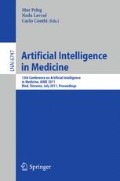Abstract
The Sleep Apnea Syndrome is a sleep disorder characterized by frequently repeated respiratory disorders during sleep. It needs the simultaneous recording of many physiological parameters to be diagnosed. The analysis of these curves is a time consuming task made by sleep Physicians. First, they detect some physiological events on each curve and then, they point out links between respiratory events and their consequences. To support the diagnosis, we used symbolic fusion on elementary events, which connects events to their sleep context - sleep-stage and body position - and to the respiratory event responsible of their occurrence. The reference indicator is the Apnea-Hypopnea Index (AHI), defined as the average hourly frequency of arisen of Apneas or Hypopneas while the patient is sleeping. We worked on the polysomnography of 59 patients, that were first completely analyzed by a sleep Physician and then analyzed by our method. We compared the ratio of the AHI got by the automatic analysis and the AHI got by the sleep Physician.
Globally, we overvalued the count of apneas and hypopneas for the group of patients with AHI ≤ 5, that are considered as healthy patients. In average, for these patients, δ = 2,71. For patients with mild or moderate Sleep Apnea Syndrome we globally found a similar AHI. In average, for these patients, δ = 1,04. For patients with severe Sleep Apnea Syndrome, we undervalued a little the count of respiratory events. In average, for these patients, δ = 0,83. This leads to the same severity class for most of the patients.
Access this chapter
Tax calculation will be finalised at checkout
Purchases are for personal use only
Preview
Unable to display preview. Download preview PDF.
References
McNicholas Walter, T.: Diagnosis of Obstructive Sleep Apnea in Adults. Proceedings of the American Thoracic Society 5, 154–160 (2008)
George, C.F.P.: Reduction In motor vehicle collisions following treatment of sleep apnoea with nasal. CPAP Thorax 56(7), 508 (2001)
Marin, J.M., Carrizo, S.J., Vicenter, E., Agusti, A.G.: Long term cardiovascular outcomes in men with obstructive sleep apnoea-hypopnea with or without treatment with continuous positive airway pressure: an observational study. Lancet 365(9464), 1046–1053 (2005)
Arzt, M., Young, T., Finn, L., Skatrud, J.B., Bradley, T.D.: Association of sleep-disordered breathing and the occurrence of stroke. AM. J. respir. Crit. Care Med. 172(11), 1447–1451 (2005)
Young, T., Peppard, P.E., Gottlieb, D.J.: Epidemiology of obstructive sleep apnea: a population health perspective. Am. J. Respir. Crit. Care Mer. 165(9), 1217–1239 (2002)
Iber, C., Ancoli-Israel, C.: The AASM Manual for the Scoring of Sleep and Associated Events: Rules, Technology and Technical Specifications Westchester: American Academy of Sleep Medicine
Silber, M.H., Ancoli-Israel, S., Bonnet, M.H., Chokroverty, S., Grigg-Damberger, M.M., Hirshkowitz, M., Kapen, S., Keenan, S.A., Kryger, M.H., Penzel, T., Pressman, M.R., Iber, C.: The Visual Scoring of Sleep in Adults. Journal of Clinical Sleep Medicine 3(2) (2007)
Anderer, P., Moreau, A., Woertz, M., Ross, M., Gruber, G., Parapatics, S., Loretz, E., Heller, E., Schmidt, A., Boeck, M., Moser, D., Kloesch, G., Saletu, B., Saletu-Zyhlarz, G.M., Danker-Hopfe, H., Zeitlhofer, J., Dorffner, G.: Computer-Assisted Sleep Classification according to the Standard of the American Academy of Sleep Medicine: Validation Study of the AASM Version of the Somnolyzer 24 X 7. Neuropsychobiology 62, 250–264 (2010)
Ugon, A., Philippe, C., Pietrasz, S., Ganascia, J.G., Lévy, P.P.: OPTISAS a new method to analyse patients with Sleep Apnea Syndrome. Stud. Health Technol. Inform. 136, 547–552 (2008)
Ugon, A., Philippe, C., Ganascia, J.G., Rakotonanahary, D., Amiel, H., Boire, J.Y., Lévy, P.P.: Evaluating OPTISAS, a visual method to analyse. In: Sleep Apnea Syndromes Conf. Proc. IEEE Eng. Med. Biol. Soc. 2009, pp. 4747–4750 (2009)
Laudy, C., Ganascia, J.-G.: Using Maximal Join for Information Fusion. In: Proceedings of IJCAI (2009)
Laudy, C., Ganascia, J.-G.: Information Fusion Using Conceptual Graphs. In: International Conference on Conceptual Structures (2008) (in proceedings)
Norman, R.G., Pal, I., Stewart, C., Walsleben, J.A., Rapoport, D.M.: Interobserver agreement among sleep scorers from different centers in a large dataset. Sleep 23(7), 901–908 (2000)
Danker-Hopfe, H.E., Kunz, D., Gruber, G., Klo, G., Lorenzo, J.L., Himanen, S.L., Kemp, B., Penzel, T., Röschke, J., Dorn, H., Schlögl, A., Trenker, E., Dorffner, G.: Interrater reliability between scorers from eight European sleep laboratories in subjects with different sleep disorders. J. Sleep Res. 13, 63–69 (2004)
Günes, S., Polat, K., Yosunkaya, S.: Efficient Sleep stage recognition system based on EEG signal using k-means clustering based feature weighting. Expert Systems with Applications 37, 7922–7928 (2010)
Tonelli de Oliveira, A.C., Martinez, D.T., Vasconcelos, L.F., Cadaval Gonalves, S., do Carmo Lenz, M., Costa Fuchs, S., Gus, M., Oliveira de Abreu-Silva, E., Beltrami Moreira, L., Danni Fuchs, F.: Diagnosis of Obstructive Sleep Apnea Syndrome and Its Outcomes With Home. Portable Monitoring Chest 135, 330–336 (2009)
Marcos, J.V., Hornero, R., Álvarez, D., Del Campo, F., Aboy, M.: Automated detection of obstructive sleep apnoea syndrome from oxygen saturation recordings using linear discriminant analysis. Medical and Biological Engineering and Computing 48(9), 895–902
Author information
Authors and Affiliations
Editor information
Editors and Affiliations
Rights and permissions
Copyright information
© 2011 Springer-Verlag Berlin Heidelberg
About this paper
Cite this paper
Ugon, A., Ganascia, JG., Philippe, C., Amiel, H., Lévy, P. (2011). How to Use Symbolic Fusion to Support the Sleep Apnea Syndrome Diagnosis. In: Peleg, M., Lavrač, N., Combi, C. (eds) Artificial Intelligence in Medicine. AIME 2011. Lecture Notes in Computer Science(), vol 6747. Springer, Berlin, Heidelberg. https://doi.org/10.1007/978-3-642-22218-4_6
Download citation
DOI: https://doi.org/10.1007/978-3-642-22218-4_6
Publisher Name: Springer, Berlin, Heidelberg
Print ISBN: 978-3-642-22217-7
Online ISBN: 978-3-642-22218-4
eBook Packages: Computer ScienceComputer Science (R0)

